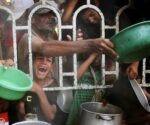Russian economy meltdown as ruble chaos erupts after yuan rises 2% | World | News
Russian President Vladimir Putin (Image: Getty)
Russia’s currency markets were thrown into fresh turmoil as the ruble plunged and the Chinese yuan surged nearly 2%, sparking fears of a deeper economic collapse amid stalled peace negotiations with Ukraine.
The yuan climbed as high as 11.1485 rubles in the first three hours of trading on Thursday — its strongest level since May — before easing back to 11.04 by late afternoon. The sharp rise triggered panic across the markets, as investors dumped rubles in favour of safer or more stable foreign currencies.
On the over-the-counter market, the dollar broke through 79 rubles for the first time in three weeks, hitting 79.55. The euro also surged, reaching 93.5 rubles — an 11-week high. The selloff coincided with another failed round of peace talks between Russian and Ukrainian officials in Istanbul, which ended in under 40 minutes and produced no major breakthroughs.
Read more: Putin forced to suddenly cancel Russia’s Navy parade after huge Ukraine losses
Read more: Meet the Russian soldier risking his life to fight Putin in Ukraine

Kremlin spokesman Dmitry Peskov (Image: Getty)
Natalia Milchakova, lead analyst at Freedom Finance Global, said: “The market was disappointed by the largely symbolic nature of Wednesday’s round of Russian-Ukrainian negotiations in Istanbul.”
Only minor agreements were reached, including commitments to continue prisoner and body exchanges, and to establish online working groups, reported the Moscow Times.
Ukraine used the opportunity to call for a direct meeting between President Volodymyr Zelensky and President Vladimir Putin, but Moscow immediately rejected the idea.
Kremlin spokesman Dmitry Peskov said: “Such a meeting can only happen after substantial groundwork has been done.”
The markets reacted swiftly. The MOEX index, which tracks 40 of Russia’s largest publicly traded companies, fell by 1%, erasing 60 billion rubles in market capitalisation. Gazprom shares slipped 1.2%, while Sberbank lost 0.94%.
Starmer & Zelenskyy agree to continue to put pressure on Russia
Ms Milchakova said: “We’re seeing a squeeze from weak corporate earnings, high interest rates and sluggish economic growth. The broader market is pricing in stagnation.”
Yevgeny Kogan, a leading investment banker, warned that falling export revenues were undermining the ruble’s position and accelerating capital flight.
Mr Kogan said: “Export earnings arrive with a delay, and we’re seeing the effects of that now. Oil prices have been under pressure, and it’s hitting the currency hard.”
In May, Russian Urals crude fell below $50 per barrel — a level well below what the Kremlin needs to sustain its budget and trade surplus. That drop is now filtering through into the currency markets, worsening an already fragile outlook.
Adding to the pressure, investors are bracing for a potential interest rate cut by the Central Bank of Russia as early as Friday. The key rate currently stands at 20%, but there is growing speculation it could be reduced to 18% in an effort to stimulate domestic lending.
Analysts at PSB Bank warned that a premature rate cut could further damage the ruble.
In a note to clients, they wrote: “Expectations of an aggressive rate cut are fuelling a wave of ruble dumping. Markets are repositioning for a softer policy stance.”
They forecast the ruble could weaken by nearly 10% by the end of the year, with the yuan potentially rising to 12 rubles — a level not seen since the early stages of the war.
The spike in the yuan is especially painful for Russian businesses, many of which now rely on Chinese imports to bypass Western sanctions. A stronger yuan translates into higher costs for consumer goods, electronics, industrial components and pharmaceuticals — further fuelling domestic inflation.
Mr Kogan said: “There’s no stability right now — not diplomatically, not economically. If the Central Bank tries to soften policy too quickly while the war continues, the ruble could break again. We’re not at the bottom yet.”
The combination of geopolitical instability, falling exports and growing pressure on household finances is pushing the Russian economy toward a breaking point.
With little progress in talks and financial markets increasingly volatile, all eyes are now on the Central Bank’s next move — and how much more pressure the ruble can take before another major correction.







